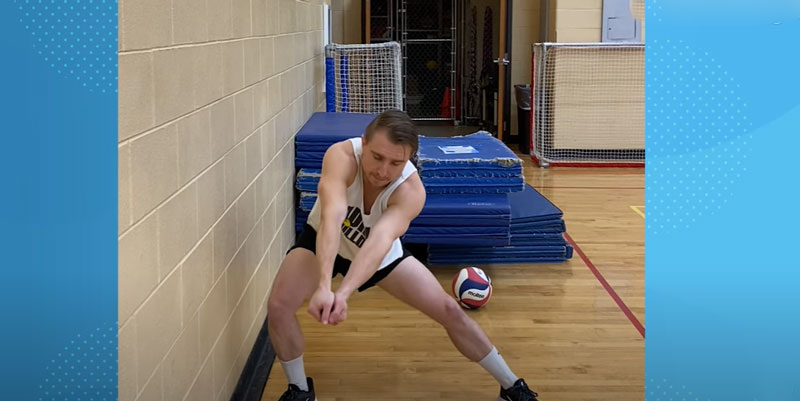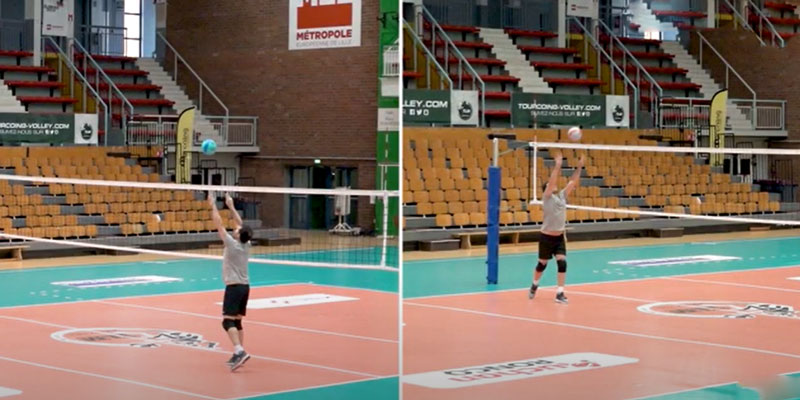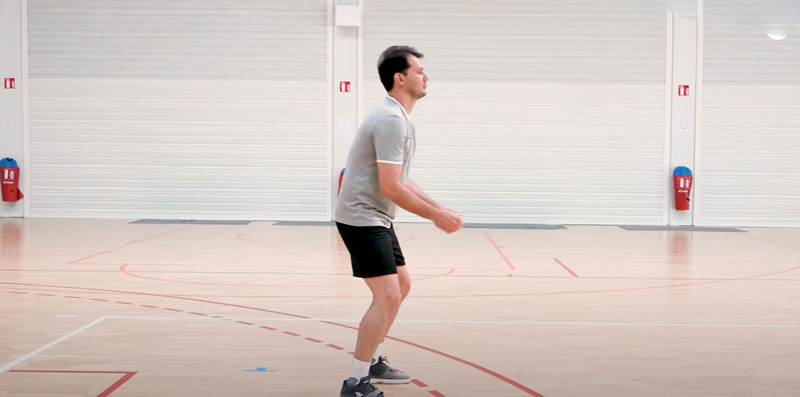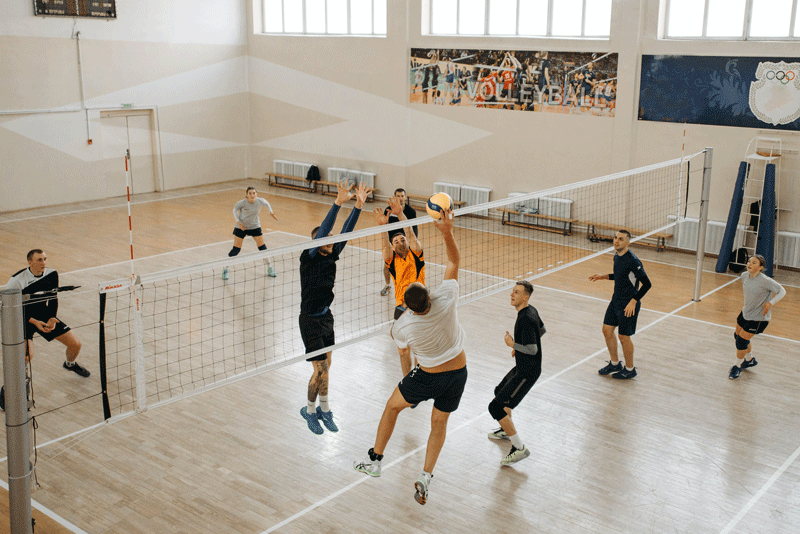7 Volleyball Passing Drills for Beginners
Consider what your approach would be to learning the game if you are a complete beginner who has barely touched a volleyball in your life.
If that happens to be the case, this article is tailored for you. The passing drills presented in this article are designed to assist anyone, regardless of age, in becoming a better player.
The primary focus of today’s discussion will be on the two fundamental volleyball passes: the forearm pass and the overhand pass.

Presented here are some of the most effective volleyball passing drills for beginners.
So let’s start!
Pair and Trio Drills for Overhand Passes
Considering a limited volleyball knowledge, beginning with the overhand pass is recommended. It stands as the most fundamental technique in volleyball, and mastering it is essential before progressing to more intricate maneuvers.
From my experience, I’ve observed that the majority of amateur teams lose points not due to powerful spikes but rather because they struggle with handling the most basic balls.
Until the point where one attains proficiency in setting balls for outside hitters and becomes adept at spiking, the majority of points will be won by merely maintaining the ball in play.
Achieving this is accomplished through the practice of overhand passes, a skill that can be learned through paired and trio exercises.
Expect to quickly grasp the overhand pass through these drills, as it is notably easier to master than the forearm pass. Additionally, due to its simplicity, there’s no need for more intense drills until you reach a higher skill level.
Pair Drill for Beginner Overhand Passes
Easily practiced in pairs, the overhand pass stands out as the ‘softest’ technique for passing a volleyball, requiring nothing more than a partner, a volleyball, and adequate free space.
For the initial steps, position yourselves approximately 15 feet apart, and with your partner throwing the ball toward you, ensure that it descends at an angled trajectory.
Your task is to return the ball to your partner by positioning your hands in front of your forehead. A key indicator of the correct position is when your thumbs and index fingers form an almost triangular shape.
Maintain bent elbows for your arms and bent knees for your legs during this process. This setup allows both your legs and arms to exert force on the ball effectively. As you straighten your arms, simultaneously straighten your legs, ensuring the ball receives force from both limbs, resulting in maximum power.
By following these steps, you should be able to return the ball to your partner. Mastering this technique is not challenging, making it likely the easiest volleyball skill to learn.
Switch roles with your partner every few minutes and continue this practice until both of you feel confident in executing the overhand pass.
Following that, introduce mobility into the drill. Instruct your partner to throw both long and short balls, requiring you to adjust your position by running either backward or toward your partner to execute the overhand pass effectively.
This drill proves highly beneficial for honing both positioning and overhand passing skills. In a real match, it’s uncommon to receive a ball while standing perfectly still, making this aspect of the drill more realistic and applicable to actual gameplay.
As time progresses, both you and your partner should attain sufficient proficiency in overhand passing, enabling effortless exchanges between the two of you.

Trio Drill for Beginner Overhand Passes
In a trio setting, consider engaging in a more advanced drill. If all three participants possess a fundamental understanding of overhand passes, collaborating on this drill can enhance collective skills.
Forming a large triangle, initiate the drill by passing the ball among yourselves. After a warm-up period, progress to more challenging and higher passes. Shift from direct passing to one of your partners and instead aim for passes nearby or between them.
Every pass necessitates the recipient to adjust their position by moving, adding an element of dynamic movement to each exchange.
This replicates the movement dynamics in actual volleyball games, where making subtle steps is crucial to achieving optimal positioning. Subsequently, your arms complete the action by executing passes or spikes with precision.
With three participants, passing the ball in the space between your two partners prompts one of them to take initiative, move to the designated spot, and execute the pass. This highlights two often overlooked aspects of volleyball—decision-making and communication.
In-game situations, balls are frequently spiked or sent over the net, finding empty spaces between two or three players. Crucially, communication becomes paramount, with the responsibility falling on the player who deems themselves the best-positioned to pass the ball.
In the training I underwent, the focus consistently revolved around vocalizing “Mine!” in such situations and actively going after the ball, even when another player was already in motion toward it.
In my observations, I’ve witnessed the loss of numerous points because the ball lands between two players, both assuming the other person will handle it.
This drill proves to be an excellent method for learning how to assess where the ball is landing, make rapid decisions, communicate effectively, position oneself strategically, and ultimately execute a proficient overhand pass.
Forearm Pass Drills
In volleyball, alongside overhand passes, forearm passes are among the most commonly used techniques. Particularly among children and beginners, there can be initial apprehension as the forearm pass is often associated with its application in blocking spikes.
Nevertheless, when you’re in the early stages of learning these passes, the emphasis is on executing them with a gentle touch.
Given the numerous variations of forearm passes, mastering them proves to be more challenging than overhand passes. It is advisable to allocate more attention to practicing forearm passes, as they are extensively employed during gameplay.
It’s important to bear in mind that these drills are fundamentally basic, and specifically designed to instruct complete beginners. As your volleyball skills advance, you may find these drills to be rudimentary and considerably easier.

Drill for Standing Forearm Passes
This drill can be performed either in pairs or in a trio, the latter involving rotation between participants.
Initiate the drill by having your partner throw the ball at you, ensuring it descends slowly and at an angled trajectory.
To optimize your performance, maintain slightly bent knees, as was done with the overhand pass. This stance is ideal for absorbing impact, facilitating an explosive response to the ball, and enabling swift adjustments to your position or the option to squat lower if needed.
Ensure that your arms are connected at the palms, with your thumbs aligned parallel to each other. Keep your forearms close together, ensuring they are not touching.
Take a position where you can use your forearms to hit the ball and execute a pass back to your partner.
Now, here’s a crucial point, and a mistake made by 99% of beginners in volleyball: refrain from bending your arms at the elbows when making contact with the ball!
A helpful visualization is to ensure that if someone were to draw a line from your palm to your shoulder, it should remain completely straight when you make contact with the ball.
You might be pondering, “How do I hit the ball?”—a valid question. The power generation comes from your legs, emphasizing the importance of being bent at the knees, coupled with the motion of swinging your arms from the shoulders, not from the elbows.
The force required to hit the ball depends on the distance between you and the person receiving the pass. After executing several dozen forearm passes, you’ll develop an understanding of the strength needed to swing your arms and accurately return the ball to your partner.
Execute this drill while in a standing position, minimizing walking movements. We will progress to different positions in our next drill.
Drill for Moving Forearm Passes
After mastering the standing forearm pass, it’s time to transition to the moving drill.
Sending a calm, standing forearm pass is a rare occurrence. In most cases, forearm passes demand dynamic actions, such as running, turning, swinging from different angles, and at times, even dropping to your knees for a more effective dig.
This drill specifically targets these dynamic aspects of forearm passes.
Commence by gathering one or two partners (in the case of a trio, ensure regular rotation among participants).
Initiate the drill by having your partner throw the ball for you to pass with your forearms. However, the crucial point is that they shouldn’t throw the ball directly at you. Instead, the balls should be directed to your left and right sides, as well as short balls, introducing variability and challenge into the drill.
Short balls might occasionally be positioned so far away from you that you’ll need to dive, digging your knees into the ground to retrieve the ball.
You can position yourself behind the sideways balls with quick reflexes for efficient retrieval. Nonetheless, some balls may be too swift, necessitating the execution of a sideways forearm pass.
The sideways forearm pass essentially mirrors the regular forearm pass, except that you’ll swing your forearms from the side rather than from between your legs.
Given its increased difficulty compared to the standing forearm drill, mastering this moving forearm pass drill will require more time and consistent practice.
Forearm Pass Drill for Groups
If there are three or more participants, practicing forearm passes can follow a similar format as overhand passes, but it’s strongly recommended to conduct this drill over a net.
An effortless approach is to divide into two teams and volley the ball from one side of the court to the other. The objective of this drill isn’t necessarily to win points or consistently complete three touches but rather to focus on controlling the ball and effectively sending it to the opposite side.
While conducting this drill, prioritize the use of the forearm pass. However, feel free to incorporate overhand passes for balls that are challenging to catch with a forearm pass, introducing versatility into your practice.
Even without a net, you can still engage in group forearm pass practice. However, the effectiveness of this drill significantly improves when you have access to a net and court lines, as these elements establish realistic limitations for the exercise.
In the absence of a court, a simple solution is to draw a line in an open field and simulate the presence of a net.
For overhand drills, a net is not essential because these passes typically don’t cover the same distance as forearm passes, and they are generally easier to control. However, if a net is available, it is highly recommended for all drills to enhance the overall training experience.
Essential Equipment Volleyball Passing Drills for Beginners

One of the advantages of volleyball is that you require very little to commence playing!
All that’s necessary is a volleyball and a friend, or even better, friends, to join you in the game.
Group forearm drills are ideally conducted with a net, and you can easily rent a volleyball court by the hour for this purpose; there’s no necessity to purchase your net.
Joining an amateur club makes things even simpler, as these clubs typically provide all the necessary equipment, eliminating the need for you to invest anything except your time.
If you find yourself alone and are willing to invest in some volleyball gear, the optimal method for solitary training involves utilizing volleyball rebounders and setting nets.
Rebounders, true to their name, efficiently bounce the ball back to you, acting as substitute partners. Meanwhile, setting nets allows you to refine your accuracy and also serve as convenient ball collectors.
For those just starting, I recommend investing in a large setting net since they can be challenging to hit accurately in the initial phases of learning.
Final Reviews
Volleyball may not be an easy sport to master, but its beginnings are accessible and straightforward.
Centered on passing the ball back and forth with a partner, the beginner drills for volleyball primarily focus on the two fundamental passes: the forearm pass and the overhand pass.
With consistent practice at least twice a week, these drills will soon become too easy, prompting you to progress to more advanced exercises.
Also Read: 4 Elementary Yet Efficient Volleyball Middle Blocker Drills
